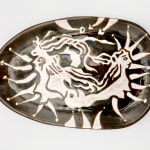Jean Lurçat
height 53.7 x width 35.9 x depth 5.1 cm
Jean Lurçat (French, 1892-1966) was born in Bruyères, Vosges, France and studied at the Acadèmie Colarossi in Paris in 1912. There, he met other artists like Matisse, Cézanne, Renoir, and Rainer Maria Rilke. Founder of the Feuilles de Mai (the leaves of May), apprenticed with painter Jean-Paul Lafitte. As WWI began, Lurçat joined the infantry and became ill. During his recovery, he worked in painting and lithography. In the 1920s was influenced by Picasso, Max Jacob, Mathe Hennebert, Herman Hesse, Jeanne Bucher, and Louis Marcoussis. And, in the early 1930s he exhibited his own works in ‘Sélections’ at Valentine Gallery in New York with some of these very influential artists mentioned above. He also created decoration and costumes for the theater and ballet inspired by the politics of the day. He is frequently called the most instrumental figure in reviving the art of designing and weaving tapestries in the 20th century. Adding to his list of accomplishments and international acclaim, he worked in multiple areas of art including ceramics, book illustrations, and wrote poetry, as well as books on tapestry. His works are collected by the likes of the Museum of Modern Art (MoMA), Centre Pompidou, The Metropolitan Museum of Art, National Gallery of Art, Washington, D.C., Dallas Museum of Art, Art Institute of Chicago, and Moderna Museet, Stockholm.
Join our mailing list
* denotes required fields
We will process the personal data you have supplied in accordance with our privacy policy (available on request). You can unsubscribe or change your preferences at any time by clicking the link in our emails.



